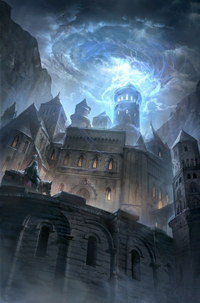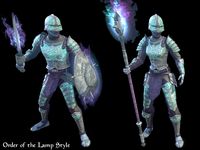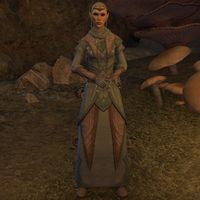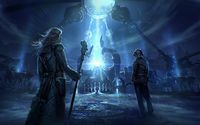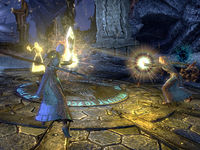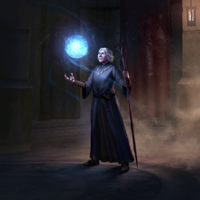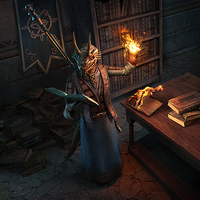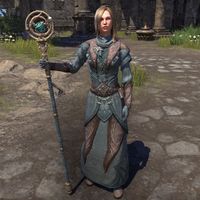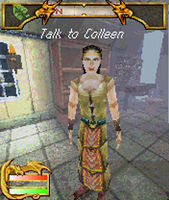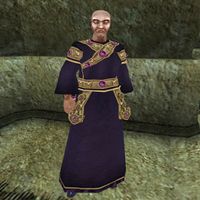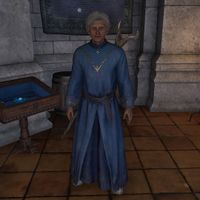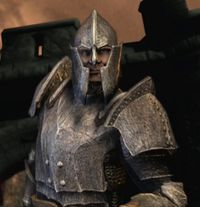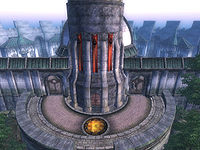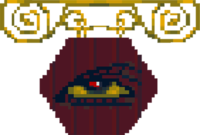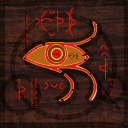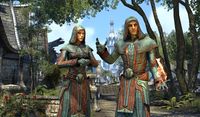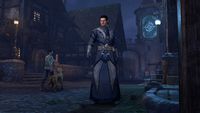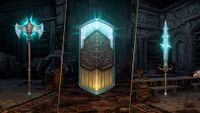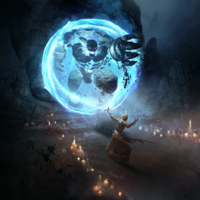Lore:Mages Guild
The Mages Guild, also known as the Guild of Mages, was founded by Vanus Galerion circa 2E 230.[1][2]:6[UOL 1] It was a professional organization once found throughout Tamriel which was dedicated to the study and application of magicka and alchemy. They were described as a collection of mages, sorcerers, and mystics, who pooled their resources and talents for the purposes of research and public charity.[3] The Aurbic Eye was the official symbol of the Guild.[4]
The Mages Guild was a powerful force in Tamriel prior to its dissolution, given free rein to operate across the land by Tamrielic rulers. A dangerous foe and aloof ally, it rarely became involved in political conflicts, but was profoundly influential when it did.[3]
Organization[edit]
The Mages Guild was led by an Arch-Mage, and guided by the Council of Mages, made up of six Archmagisters (one of them the Arch-Mage). By the Third Era, the Arch-Mage and the Council of Mages were headquartered at the Guild's Arcane University in the Imperial City, which the Guild held out as the foremost magical research center in Tamriel ever since its founding in the Second Era.[5] The Guild had a mandate to establish laws on the proper use of magic,[1] and the Council decided important Guild policies, such as regulations on necromancy, the sale of spells in a local Guild Hall, and how Guild law would be enforced. They also administered recruitment. However, local Guilds demonstrated some discretion in their rulemaking, leading to sometimes dramatic differences. Guild halls existed in most of Tamriel's cities, and each was run by a local Guild Magister (alternatively known as a Hall Magister). Below him were the Master of Incunabula (alternatively called the High Incunabulist),[6] keeper of the guildhall's tomes,[7] and the Master at Arms. The Master of Incunabula had a counsel of two, the Master of Academia and the Master of the Scrye. The Master at Arms also had a counsel, the Master of Initiates and the Palatinus (the leader of the local chapter of the Order of the Lamp).[3] The Mages Guild had a system for lodging complaints, such as for the misattribution of credit among Guild members.[8]
Candidates for membership had to present themselves to the Steward of a Guild Hall for examination and approval. The Guild's charter outlined rules of conduct between members; crimes against fellow members were treated with the harshest discipline, and whether the perpetrator could regain their former status in the Guild was determined by the Arch-Mage. Starting from 3E 431, any crime committed against the guilt resulted in an immediate suspension of Guild membership that could be lifted at the discretion of the Steward of the Council of Mages. Multiple suspensions could result in permanent dismissal from the Guild.[1] The Guild also had rules about fraternization and lewd advances.[9]
In Third Era Cyrodiil, members would be given magical staves, which were considered important status symbols.[10][11] Advancement through the ranks would be met with various rewards, such as powerful spells.[10][12] When needed for Guild business, members were sometimes also freely provided Guild resources, such as magic scrolls.[13][14][15]
The position of "Chronicler" was a somewhat informal title within the Mages Guild hierarchy, passed between Adepts with a penchant for the "identification and illumination of ancient secrets". Their duties involved selling arcane goods, which made some question if it was actually a "fancy title for a clerk".[16] Chroniclers were known to sometimes compile and copy ancient texts for analysis and dissemination through the Guild.[8] The Guild would provide preservation spells and cleaning supplies so ancient tomes in their custody could be maintained.[17][18][19] Some Guild members were tasked with keeping an adequate supply of magical foci, such as staves, on hand for any mages that required them.[20]
The Mages Guild had a variety of means of communication. Conjured Daedra such as Dremora might be dispatched to deliver messages to other organizations, such as the Imperial Watch.[21][22] Mages Guild Message Stones could conjure projections of the sender to communicate with the recipient, while Summoning Medallions allowed the recipient to directly summon the sender to their location.[23]
Some guildhalls were known to be protected with magical wards.[24] The Guild was also known to often utilize Mages Guild Sentry Cats as a security measure, leading to them being a common sight in guild halls. The keen senses of these cats enabled them to detect all manner of intruders, even those that were magically concealed or from realms of Oblivion.[25]
Services[edit]
The Mages Guild Charter from the Emperor specified that the Guild must provide magic services to the public. Anyone could purchase potions, alchemical ingredients, magical items, and a selection of standard spells from the Guild. However, training, goods, and services were cheaper for members, and the Guild stewards were sometimes able to provide members with work. Services deemed potentially dangerous to the public at large, such as spellmaking and enchanting, were only made available to higher-ranked members in good standing.[1][26] The Guild was known to sell standardized, ready-made spells that could be cast even without understanding of the underlying magical theory, which came to be the usual manner in which spells were acquired. However, such spells were generally not as powerful as those cast by a mage with real knowledge.[27] Spells available for purchase were distributed across the various halls according to the Mages Guild Charter, with each specializing in a specific school of magic.[1] One could also pay the Guild to replace the enchantment on a magical item.[28] The Guild also evaluated weapons and items brought to them for their magical potential.[29]
The Mages Guild is credited with making magic, once restricted to the aristocracy, intelligentsia, and solitary covens and mages, much more available to the public.[3] Some sources claim that the praxes and rituals used by all modern potionmakers, itemmakers, and spellmakers were originally codified by the Guild's founder Vanus Galerion, who is credited with devising the schools of magic so they would be comprehensible by the masses, as well as inventing common tools of alchemy and enchanting so everyone could safely perform magic, making him the progenitor of modern magic in Tamriel. Over time, Guild restrictions on magical services would change along with risk assessments.[30] The Guild was sometimes asked to provide more obscure magical services, such as using Stone Magic to reshape structures.[31]
The Mages Guild were Tamriel's leading archaeologists, and were somewhat notorious for their zealous pursuits of a variety of artifacts, such the Guardian's Eye.[32] The Guild was willing to steal to get such artifacts on occasion,[33] and some suspected they were willing to go further than that.[32] The Guild was known to maintain vaults of magical artifacts. Dangerous relics were sequestered in such vaults under heavy arcane wards, but access could be granted to qualified guild members for research purposes, following a formal request.[34][35]
Before its disbandment, one could purchase instant teleportation between the regional halls. This service was available to members and non-members alike, though members were generally given a significant discount.[36] It also had a subsidiary known as the Travelers League, only available to high-ranking members, which could teleport someone from anywhere in the world. This League was present in the Iliac Bay during the fifth century of the Third Era.[37] Another Mages Guild subsidiary of this time and place was the Cabal, composed of conjurers who'd provide Guild members of sufficient rank the service of summoning the Daedric Princes on their Summoning Days.[38] The Mages Guild often employed portals designed to move people and material quickly, which were less draining than personal teleportation spells and made it possible for many people to travel en masse.[39] The Guild would also use Portal Anchors, arcane devices that stabilize portals for a longer duration when needing to transport groups.[40][41]
The Guild often intervened upon reports of dangerous magical practices, either at the behest of the Council of Mages, or by order of the local guild hall heads. A rogue mage killing traveling merchants or a necromancer coven might draw a single Guild investigator or warrant an entire contingent of battlemages.[42] Members might be asked to infiltrate rogue magical organizations or slay a necromancer attempting to ascend to lichdom.[14][15][5][43] Accounts by members of the Guild's Order of the Lamp describe being sent on missions involving fighting Dremora, raging Atronachs, and massive armies of the undead summoned by necromancers.[44]
Circa 3E 433, the bodyguard of the Imperial Battlemage of Tamriel was a member of the Mages Guild.[45]
History[edit]
Second Era[edit]
The Mages Guild was founded by Vanus Galerion circa 2E 230.[1][2]:6[UOL 1] Study of magic had been dominated by many separate, isolated groups, such as the Psijic Order (of which Galerion was a member), which had begun falling out of grace with society. Its policy of isolationism led to mistrust, and its religion (best described as a type of ancestor worship) was an increasingly unfashionable philosophy. With the formation of the Mages Guild, Galerion sought to both unify the community of mages in the study of magic as well as spread to the public the benefits of the magical arts.[3] Galerion named the top leadership position the Arch-Mage in memory of Shalidor, the first recorded mage to claim the title.[46]
The idea of mages, sorcerers, and assorted mystics pooling their resources for the purpose of research and public charity was a revolutionary concept in the early Second Era, and elicited a great deal of animosity against Galerion. In the "Charter Conclave" of 2E 230, he was brought to explain himself to his former mentor Iachesis, the King of Firsthold Rilis XII, and other notable figures.[6][47] While Galerion's speech was not recorded for posterity (creating much scholarly interest into what rhetoric Galerion must have employed), the charter was approved.[3] The fearful commonfolk had been urging their king to settle the issue of "Galerion's Folly" (as it was known at the time), but instead Kinlord Rilis became a sort of co-founder of the Guild. Some posit he saw Galerion's plan as a way to further his own ends, as he later made pacts with Daedra and demonstrated sadistic tendencies. Before his cruelty became well-known, the common folk would believe that the Kinlord had made a deal with "dangerous mages", a misconception the Guild hastily sought to rectify.[6]
The passing of the Guild Act of 2E 321 would further legitimize the Mages Guild by sanctioning its presence within the Second Empire.[1][48]
Postformation[edit]
Immediately following the formation of the Mages Guild, security concerns emerged. Initially hiring guards, Vanus Galerion realized what the Tamrielic nobility had known for centuries: money alone did not buy loyalty. This led Galerion to form the knightly Order of the Lamp.[3] The signing of the Guild Act also soon allowed for a great proliferation of knowledge on exotic materials. The Guild is credited with discovering how to refine magical ores to create weapons and armor surpassing even those made of ebony in their quality.[49]
Before Mages Guild chapter houses had spread to the mainland of Tamriel, Galerion crafted extraordinarily powerful tools of enchanting and alchemy. These original tools were more automated, essentially providing the layperson without any understanding of magic the capabilities of a master enchanter and alchemist for any purpose, so long as they could pay for it. Even an enchanted sword that could "cleave the world in twain" is said to have been theoretically possible to make through these original tools, obstructed only by enormous cost in magicka and gold. This level of accessibility is said to have resulted in a number of incidents involving laypeople wielding dangerous arcane objects well beyond their ken, which led Galerion to have the originals destroyed and replaced by less powerful versions requiring more expertise from the user.[30]
The Guild gradually gained footholds in mainland Tamriel. Many superstitious and fearful rulers banned them from their lands, but their descendants would realize the benefits of allowing Guild operations in their territory. While the Mages Guild strove for neutrality in political conflicts, on rare occasions its participation has been the ultimate decider, and it proved to be a dangerous foe to its enemies.[3] The Guild was a boon for the Bretons, who are known for their innate magical ability and divisive political culture. Urban Bretons had their children were tested for magical potential at an early age and systematically organized alongside the Mages Guild hierarchy. Those with talent entered apprenticeship programs funded by the Mages Guild or independent sponsorships.[50] A notable Breton alumni is Gyron Vardengroet, who discovered the secret to immortality through alchemy.[51] However, rural areas of High Rock often remained under the sway of shamans and covens.[50]
As only Altmer were permitted to be on the Summerset Isle, Mages Guild halls there consisted of only High Elves until Queen Ayrenn opened the borders to the other races.[52][53] The College of Sapiarchs in Summerset viewed the Mages Guild's as beneath them, possessing a more limited understanding of magic than their own, and hindered the Guild's activities in Lillandril. Members of the local Mages Guild believed this was attitude was due to fear and racial animosity.[54]
Early on in the Second Era, Felix "Blackcaster" Augustus and his followers split from the Mages Guild to practice their arts in Craglorn, where they opened a mage's academy. While some considered them hedge mages rebelling against the authority of the Mages Guild, the Blackcasters objected to the claim that they were renegades. They asserted their endeavor had nothing to do with any disagreements with the Guild, but was instead motivated by a desire to explore territories beyond the Guild's reach, and that Felix Blackcaster remained a Mages Guild member in high standing who kept in contact with his superiors in the Mages Guild.[55] Despite this, members of the Mages Guild did seem to view the Blackcasters as renegades.[56]
Mannimarco Gains Influence[edit]
Seeking to normalize necromancy and gain a following to his discipline, Mannimarco created his Order of the Black Worm to rival the ascendant Mages Guild,[57][58] and the two organizations have warred since the Guild's founding.[59] Vanus Galerion believed Mannimarco was responsible for the spell to trap a soul becoming common knowledge among mages, leading to strictures in the Guild against soul-trapping sentient mortals. Due to the readily available presence of soul gems in nearly every bazaar of Tamriel, Galerion grudgingly co-opted the practice in an effort to control its use. Since the art was not a part of the core curriculum of the Guild, being taught only to the most experienced and dependable wizards for specific uses, Galerion codified and systematized the various practices of soul-trapping magics into a grimoire of a few, certain spells to be taught to students. Souls were classified into two classes; the legal, "White" souls consisted of smaller essences from beasts or animals; the illegal, "Black" souls were derived from sentient mortals. Only spells that would capture the legal "White" souls were taught.[60] In time, it became impossible for standard soul trap spells taught to capture a Black Soul within a regular soul gem, instead requiring the use of the more dangerous and elusive Black Soul Gems.[61]
At some point following the Guild's formation, Vastarie, a necromancer who had been a disciple in the Psijic Order alongside Galerion and had worked with Mannimarco to retrieve the first Black Soul Gems from Coldharbour, attempted to present the Sigil Geodes she'd invented to the fledgling Guild. The geodes allowed for a soul to be captured upon the moment of death and then be interrogated for their knowledge at the mage's leisure. The soul could then be released or moved between crystals at will without the need of enchantment. The demonstration was attended by a number of students and Galerion himself, but when it ended, it is said that Galerion's face was white with horror. He delivered a furious and vindictive speech condemning the practice and stormed out, with some students following him.[62]
The Interregnum[edit]
While the Guild maintained a strict hierarchy, many knew that this masked severe disagreements. Galerion eventually left the Guild in disgust, claiming it had become "nothing more than an intricate morass of political infighting."[3] Despite this, Galerion still held the venerable title of Archmagister Emeritus, and influenced many Guild affairs.[60] His hiatus would last for over a century, but he would eventually return to his duties as the Archmagister due to the crisis that would follow the Soulburst in 2E 578.[63] Mannimarco and his cult made a flurry of political actions to gain power,[64] converting Empress Regent Clivia Tharn to worshipping Molag Bal and manipulating her into expelling the Mages Guild from the Imperial City so that his Worm Cult could operate freely. Mannimarco effectively became the true power behind the Ruby Throne.[65][66][67] The Mages Guild had its charter revoked, and was replaced by the Order of the Black Worm under the alias of the Fellowship of Anchorites.[68]
While the Mages Guild got a foothold in Skyrim,[28] the province's College of Winterhold remained independent from it.[69] From Aetherius, the departed founder of the College of Winterhold, Shalidor, perceived a threat to his legacy, leading him to manifest on Nirn circa 2E 582. The legacy which concerned him was not the College, but the island of Eyevea. He had established as a retreat and sanctuary for all mages, but it was under threat by the trickster Sheogorath, so Shalidor enlisted the help of the Guild to save it. The Guild was ultimately able to re-establish a central headquarters on Eyevea.[70]
During this time, the Order of the Eye was a sub-faction of the Guild dedicated to protecting against extraplanar threats.[71] They specialized in the use of the magic of the Sight (divination), and worked across Tamriel to research the unexpected effects of the Planemeld. The Order scoured ruins and tombs, sought out planar rifts, hunted down Daedric artifacts associated with Sheogorath, and investigated visions related to the Skeleton Key and the looming Triad crisis.[71][72][73][74] Guild members also dealt with other arcane threats, such as the Mage's Staff, a great Celestial obelisk that had fallen to Craglorn which housed a separate plane. Its landfall created a blasted and magic-infested landscape known as the Spellscar. Guild member Sara Benele played a pivotal role in preventing an explosion of magic from the obelisk that would have destroyed all of Craglorn.[75]
Other affairs the Guild became involved in at this time included Arch-Mage Galerion's disciplinary action against the rogue Guild warlock Carindon for his imprisonment of the Changeling Selene, which violated an accord between Selene and the Guild,[76] and an investigation into the disappearance of the Oracle Marieve (which they learned was due to the machinations of the Triad).[77]
Elsewhere, in the Telvanni Peninsula, Guild warlock Vanton experimented with a relic called the Dreamstone, an artifact known to mentally influence its holders and drive them insane,[35] with somewhat predictable results. The nightmare Daedra of Vaermina that was housed within, Ansuul the Tormentor, warped Vanton's mindscape into a place of nightmares, hoping to break his will so she could fully take over and enter the waking world.[78] Worried that Ansuul would eventually succeed unleash her power upon the waking world, the Mages Guild enlisted aid to enter Vanton's mindscape and slay Ansuul.[79][80][34]
At some point, the Mages Guild had placed arcane wards around the Aetherian Archive, a mysterious tower housing the remnant of a "once-Great Source of knowledge and power" in order to prevent its misuse, guarded by a fractured fraternity called the Firstmages. In 2E 582, a rogue Guild wizard that had been taught all he knew by Galerion himself, Brulo Rlane, cracked the wards and breached the tower, hoping to claim the Great Source within for himself. One of the Firstmages, Arnure, reached out to Galerion's aid to prevent this, as Brulo would bring about terrible calamity that would endanger Nirn. Brulo opened planar breaches to obstruct Galerion, unleashing shadowy Daedric beings to keep the Arch-Mage off balance. Galerion went to work on sealing the planar breaches and summoned the Vestige to the Archive to fend off Brulo's minions while Galerion closed the breaches and engaged Brulo in a magical duel. Afterward, the victorious Galerion insisted on departing quickly, as the power of the Great Source was too much for anyone but the Firstmages linger around long, even himself.[81][82]
Though the Mages Guild had a presence in Hammerfell, spellcasters were shunned in the province, as they were generally believed by Redguards to be wicked individuals who steal souls and tamper with minds.[83] The Three Banners War was a period of intense conflict, yet the Crowns still pressured King Fahara'jad to ban any Guild members from Redguard militaries.[84]
A Mages Guild delegation was invited to take part in the Three Banner War peace talks organized by the Society of the Steadfast on the Systres Archipelago island of High Isle. The Guild was also tasked to create enchanted medallions that would allow the wearers entry to the secret location where the talks would take place. Guild scholar Valessea, aided by the Vestige, investigated the activities of the Ascendant Order, who were trying to disrupt the talks and steal the medallions. The Guild's chosen representative, Arch-Magister Delric, was killed when he touched his recovered medallion, as the Order had replaced the original enchantment to assassinate him. Valessea rendered safe the other medallions by using a dispelling power, used a tracking spell to locate the medallion of the Fighters Guild representative, who had turned traitor, scried for the missing Alliance leaders, and investigated the Druidic magic the Order employed in its attacks, which culminated in Valessea joining the defense of All-Flags Castle against the forces of the Ascendant Magus. With the Order's plot thoroughly defeated, Valessea was chosen as the Guild's new representative at the peace talks.[85][86]
Concurrent with these peace talks was the Mages Guild's research into Druidic magic on the Systres Archipelago, with the volatile magic of the Eldertide Circle being prioritized.[87] Some of the Systrean knights of the Oaken Order managed to overshadow Mages Guild spellwrights in the art of Destruction and Conjuration magic. The Guild's conjurers were especially threatened by the Oaken Order's skills, and derided them as practitioners of hedge magic.[88]
Scribing, a "metamagical theoryset"[8] created by Archmage Ulfsild the Evergreen and the Luminaries of Magic,[89][90][91] was a lost art up until the time of the Three Banners War, when it was rediscovered by the Order of the Lamp. Vanus Galerion was particularly enthusiastic of the possibilities it would open up, with early ideas being altars being installed in every Guild Hall, or that scribing would perhaps one day be taught in the wilds.[92] The first nine Scribing Scripts circulated among the Mages Guild were said to have been hand-copied and examined by Galerion himself, resulting in reference materials that were, in some cases, even better than the originals. Lamp Knight and Mages Guild Chronicler Firandil complained that Galerion was receiving credit for his own work.[8] Scribing eventually evolved into modern spellcrafting systems.[UOL 2]
Invasion of Coldharbour[edit]
Vanus Galerion became increasingly concerned about the activities of the Worm Cult and the looming threat of Molag Bal's Planemeld. He helped attempt to negotiate a ceasefire in the Three Banners War so that the factions could commit their full resources to an assault on Coldharbour. This negotiation, on the island of Stirk, faced significant hurdles. After weathering an attack by Molag Bal's forces, the alliances did endorse action, but a smaller one than what Galerion had hoped for: the combined Mages Guild and Fighters Guild forces would invade Coldharbour.[70][93][94]
Though initially scattered across Coldharbour by the realm's defenses, the invasion force was gradually reassembled in the Hollow City, a sanctuary of Meridia which was within Coldharbour yet protected against the God of Schemes.[95] The last Ayleid king, Laloriaran Dynar, who had been brought to Coldharbour alongside the Hollow City and been kept alive by the Daedra for centuries of torture, was rescued, and along with Galerion, he assumed leadership of the forces assembling in the Hollow City.[96] Upon teleporting into Coldharbour, Galerion had found himself alone and was soon captured by the Daedra, who spared him so that he could be exploited to accelerate the Planemeld from months to hours through his powerful magic.[97] Failing to use Galerion as a power source for the Great Shackle due to his fragmentation of his essence, the Daedra attempted to use his shards to power the construction of their Dark Anchors instead.[98] This was a costly mistake, as once restored and freed, Galerion sabotaged their Planemeld operations by destroying the Great Shackle meant to pull Nirn into Coldharbour using metaphysical chains cast through the planar chaos, though not before a Planar Vortex formed.[94][99] Galerion than made his way to the Hollow City, where he focused on devising a plan to foil Bal's scheme entirely.[70][94][100]
The combined guild forces, dubbed the "Army of Meridia", crossed the Chasm of Coldharbour, but were met resistance from the vampires of the Orchard, which were potentially rendered mindless through Galerion's blood magic, and other minions of Bal.[94][101][102][103] Eventually, a small group managed to navigate through Coldharbour and gain the aid of Meridia, before entering the Planar Vortex that still threatened to pull in Nirn. The group utilized the Light of Meridia, a powerful crystalline artifact of the Hollow City magically prepared by Galerion and Gabrielle Benele, to disperse the Vortex and destroy all progress Bal had made on the Planemeld, simultaneously ensuring Nirn wouldn't be destroyed in the event by breaking the Anchors that bound the Vortex together before the Light was unleashed.[94][104][105]
The Stirk Fellowship[edit]
Sometime after the Planemeld, the Mages and Fighters Guilds were targeted by the resurrected Worm Cult. With the guild hall underneath Shornhelm devastated, and the Fighters Guild leader Merric at-Aswala killed by a strange new device known as a Soul Reaper, Mages Guild leader Vanus Galerion arrived at the city to accompany his compatriots to the Cult's hideout near the lighthouse west of Northpoint. There, they learned the Worm Cult planned to hide the Soul Reapers across Tamriel and then activate them to siphon souls at a massive scale, making them a top priority target to disable.[106] However, Vanus Galerion was abducted by the Harvester Mezamma disguised as trusted ally Skordo the Knife, who teleported him to the remote island of Solstice. Vanus's staff was left behind, which Gabrielle Benele retrieved to put it under safekeeping. With the two organizations now without their guildmasters, the guilds held a summit on Stirk to negotiate with the ambassadors of the Three Alliances for allies. They proposed the creation of Stirk Fellowship for the purpose of combating this new threat when Vanus projected himself out of his staff on Stirk and informed them of the danger the Soul Reapers posed.[107][108]
With Gabrielle Benele and Prince Azah assuming the roles of acting guildmasters for the Mages Guild and Fighters Guild respectively, they sought to fully convince the Three Alliances to join their fight against the Worm Cult. Azah already had significant influence with the Daggerfall Covenant, being the son of one of the Covenant's leaders, King Fahara'jad.[109] Gabrielle and Azah invited the Eyes of the Queen spymaster, Razum-dar, to inspect the devastated guild halls as well as their captured enemy correspondences. Razum-dar's investigations were fruitful, allowing him to deduce that the new leader of the Necromancers was a figure known as Wormblood, who had close ties or possibly a blood relation to Mannimarco. The evidence convinced the Aldmeri Dominion to combat the Worm Cult resurgence.[110] Gabrielle concurrently entrusted the Argonian Walks-In-Ash with being the link to convince the Ebonheart Pact to join the Stirk Fellowship, as they were a founding member of the Pact and also a combatant that fought alongside the Mages Guild during the Tamrielic Invasion of Coldharbour.[111]
The Final Clash of Mannimarco and Galerion[edit]
Sometime after 2E 582,[UOL 3] Vanus Galerion would confront the lich Mannimarco, his once childhood friend and orchestrator of the Planemeld, in a mountain pass with Mages Guild fighters and the Lamp Knights. As the two armies clashed, lightning and frost cascaded around them. The necromancers summoned various undead creatures to their sides which were battered by streams of light forged by the battlemages. It is said that "with but a touch" Galerion "shook the mountain to its base" and the undead horde fell. However, heeding their dying cries the King of Worms, Mannimarco, finally emerged. Galerion noticed, then, that Mannimarco was no longer alive: he had turned himself into a lich, thus gaining immortality. It is said Mannimarco opened his maw and exhaled a miasma of darkness over the mountain, causing all present to feel the touch of death. Eventually, the Worm King's power failed and his artifacts were ripped from him, ending the battle. For a long time Mannimarco was thought to have died in the battle. Although Galerion himself was killed, Mannimarco clung to his state of undeath, and the practice of necromancy would live on. Mannimarco's followers were either killed or scattered, and the triumphant army Galerion left behind secured his legacy and the legacy of the Mages Guild.[1][47]
Third Era[edit]
Circa 2E 864, during the Tiber War, the Archmage of the Mages Guild on Stros M'Kai, Voa, fought for the Crowns at the Battle of Hunding Bay. He attempted to save Prince A'tor from a poisoned arrow, but he, along with the rest of the ship, were burned alive by the dragon Nafaalilargus.[112] He was succeeded by Archmage Jaganvir, who bent to the whims of Amiel Richton, the new Imperial Provisional Governor of Stros M'Kai after the Crown's defeat.[113]
With the signing of the Armistice at the end of the Second Era, hostilities arose between House Telvanni and the Mages Guild that would linger to the end of the Third Era. It created a monopoly for the Guild on all public magical services, as only they can officially offer spells and training to non-members.[114] Believing that the two cannot coexist peacefully, Arch-Mage Trebonius Artorius of Vvardenfell's Mages Guild demanded that the remaining Telvanni councilors be assassinated, as the price for his retirement and replacement by the Nerevarine as head of the Mages Guild. However, the Nerevarine appears not to have complied with the request, for at least one—Neloth—is known to have survived, although shortly afterwards he left Morrowind and moved to Solstheim.[115][116] Trebonius himself was ousted from his position as the province's Arch-Mage either peacefully or with force.[117]
Circa 3E 405, the Mages Guild in the Iliac Bay region had a rivalry with the School of Julianos, which was said to be second only to the Mages Guild.[118]
At least by the late Third Era, the Mages Guild maintained close relations with the Imperial Battlemages, who acted as guards for the Arcane University.[119] Around this time, a young Martin Septim was an apprentice of the Guild, but like many of his fellow peers he grew impatient with its restrictions, and they turned to worshipping Sanguine instead, learning much about the riddles of the magic of Daedra as a way to gain knowledge and power.[120]
In 3E 431, narrowly-elected Arch-Mage Hannibal Traven made numerous policy changes, tightening admission to the Arcane University and banning the practice of necromancy from the Mages Guild. Consequently, a severe split emerged within the Guild. Half the Council of Mages resigned, and Magister Ulliceta gra-Kogg of Orsinium was forced to flee for her adherence to necromancy. Technically, Traven was only enforcing the ban on necromancy which had been in place since the Guild's founding. However, several Archmagisters had been content to ignore it, while some reputedly practiced it in secret.[121] As a result of this enforcement, the only other members on the Council as the Third Era was drawing to a close were Caranya, Irlav Jarol and Council Steward Raminus Polus.[122]
In 3E 433, Mannimarco, the King of Worms, returned to Tamriel, attracting recruits alienated by the Guild's ban on necromancy to join his Order of the Black Worm. Mannimarco's mages attacked the Guild, even managing to burn down the Bruma Guild Hall. Traven sought the help of the Hero of Kvatch, and ultimately sacrificed himself to save both the Guild and Tamriel, sealing his own soul within a Colossal Black Soul Gem so that it'd provide the Hero of Kvatch with protection from Mannimarco's enthralling magic and thus make it possible to face the King of Worms in combat, before designating the Hero as his successor.[122][5] During this time, the Mages Guild would make several repairs to the Dwemeri orrery housed in the center of the Arcane University, bringing it back to functionality after an unknown time in disrepair.[123]
Fourth Era[edit]
During the early Fourth Era, at some point prior to 4E 48, the Mages Guild dissolved.[124][69] Following this dissolution, the Synod and the College of Whispers emerged as the two Imperially-recognized magical organizations.[124] Other guilds of mages were also known to exist at this time.[125][126]
The influence of the Mages Guild continues to be felt in all walks of life, even on mundane topics like food preservation. According to Urzhag gro-Larak, apprentice of Balagog gro-Nolob, a technique to preserve food via cryomancy was perfected by the Rimmen Mages Guild in the Second Era. This technique is still used by Khajiit caravans to preserve their bananas during their trips.[127]
Teachings[edit]

Many of the greatest mages graduated from the Mages Guild. This was partly due to the Guild's prominence in Tamriel and open-ended recruitment policy. The Mages Guild encouraged all mages of varying skill and interest to join, and promoted an active regimen of practicing one's chosen spells to gain mastery over their specific school of magic.[26]
The Mages Guild taught its students to use magic in various ways, including the summoning of Elemental Daedra, Alchemy, and Dark Magic. After several centuries, this aggregation of magical research and knowledge became haphazard and disorganized, and a new model based off the Shad Astula Academy's curricula was proposed by Gabrielle Benele around the time of the Three Banners War.[129] Vanus Galerion sent Gabrielle a stack of rejection letters for this proposal,[130] yet would later be credited for creating the schools of magic.[121]
While the specific schools changed over the centuries, seven major schools of spell-casting and two other schools of arcane arts were taught extensively by the Mages Guild, providing students with a better structure to learn the concepts of wizardry in half the time of the old curricula.[129]
- Alteration spells alter the physical and magical properties of the target, making objects heavier or lighter, granting elemental and physical shields, bestowing the ability to breath under and walk on water, and opening locks.
- Conjuration spells call upon otherworldly entities through telepathy, and certain skilled Conjuration mages can develop telepathic links with each other. Conjuration spells augment the caster by granting them Daedric and Undead guardians, Daedric weapons and armor, and the ability to repel the undead.
- Destruction spells harm the target by damaging its health with either elemental or magical attacks, draining and damaging its attributes, skills, health, magic, and fatigue, making it weak to the elements, poisons and magic, and corroding its armor and weapons.
- Illusion spells affect light and a sentient target's mind. They can harm the target by commanding, demoralizing, paralyzing, silencing, and causing it to frenzy, or augmenting it by rallying, charming, calming it, granting it invisibility, night-vision, translucency and illuminating it.
- Mysticism is an obscure school, though its spells seem to manipulate magicka itself. With spells that bind the target's soul, this school is closely related to necromancy. Spells can augment the target by granting it the ability to detect life, reflect damage, absorb and reflect spells or harm it by dispelling its magical effects and trapping its soul. Spells can also move objects through space with telekinesis. The nature of the School of Mysticism is the subject of much scholarly debate.[131]
- Restoration spells augment the target by restoring its health, attributes, stamina, and magicka, fortifying its health, attributes, skills, stamina, and magicka, granting it resistances to the elements, magic, disease, paralysis, poison, and un-enchanted weapons, curing it of disease, poison and paralysis or harm the target by absorbing its health, magicka, stamina, attributes and skills.
- Thaumaturgy does not change the appearance or structure of a force or object, but can manipulate laws temporarily. This allows thaumaturges to perform acts which can only be achieved through brute force in other schools of magic, such as levitation, etherealness, detection, pacification, water walking, teleportation, summoning and the manipulation of other magical forces.[132][133]
- Alchemy is the act of mixing, boiling and distilling various substances to obtain their chemo-magical properties and create potions and poisons.
- Enchanting is the act of endowing objects with magical properties through the use of a soul, almost always with the use of a soul gem. The effects of enchanted apparel may augment the wearer, and the effects of enchanted weapons may harm the target.
Besides banning or discouraging necromancy,[121] the Guild also outlawed "beastfolk magic", which they fear as dangerous wild hedge-wizardry commonly practiced by the Reachmen, who are said to have learned it from the Orcs.[50][134]
Subsidiary Branches[edit]
- Order of the Lamp - Knightly order acting as protectors of the Guild, founded by Vanus Galerion.[3][47]
- Order of the Eye - Order specializing in Sight Magic, tasked with investigating extraplanar dangers[72][71][73]
- Travelers League - Tasked with providing teleportation services from anywhere in the world to high-ranking Guild members.[37]
- Cabal - Tasked with summoning the Daedric Princes on their Summoning Days in service to high-ranked Guild members.[38]
Hall of Arch-Mages[edit]
Arch-Mage Vanus Galerion, 2E 582 (ESO)
Acting Guildmaster Gabrielle Benele, 2E 582 (ESO)
Archmage Jaganvir, 2E 864 (Redguard)
Mage Guildmaster Colleen, 3E 397 (Shadowkey)
Arch-Mage Trebonius Artorius, 3E 427 (Morrowind)
Arch-Mage Hannibal Traven, 3E 433 (Oblivion)
The Hero of Kvatch, 3E 433 (Oblivion)
Gallery[edit]
The Arcane University, headquarters of the Mages Guild, circa 3E 433 (Oblivion)
Mages Guild banner circa 2E 582 (ESO)
Mages Guild Sign during the Imperial Simulacrum (Arena)
Mages Guild Sign circa 3E 405 (Daggerfall)
Mages Guild Sign circa 2E 864 (Redguard)
Mages Guild Sign circa 3E 427 (Morrowind)
Notes[edit]
- During the Witches Festival, the Mages Guild gets most of the business since weapons and items are evaluated for their mystic potential free of charge and magic spells are one half their usual price. Scrolls are also discounted.[29]
- Aspiring Guild apprentices sometimes use weapons decorated with the Aurbic Eye, the Guild's symbol.[135]
- Some Guild members were once described as "aggressively atheistic", as they disfavored theories from colleagues which relied upon assuming the validity of myths surrounding the Aedra and a purpose to creation.[92]
See Also[edit]
- For game-specific information, see the Arena, Daggerfall, Morrowind, Shadowkey, Oblivion, and Elder Scrolls Online articles.
References[edit]
- ^ a b c d e f g h Mages Guild Charter
- ^ a b The Daggerfall Chronicles
- ^ a b c d e f g h i j Origin of the Mages Guild — The Archmage Salarth
- ^ Mages Guild rank symbols in Oblivion
- ^ a b c Hannibal Traven's dialogue in Oblivion
- ^ a b c Kinlord Rilis and the Mages Guild — High Incunabulist Valaste of the Mages Guild
- ^ Valaste's dialogue in ESO
- ^ a b c d The Largesse of the Archmagister in ESO
- ^ Khara-ko's dialogue in ESO
- ^ a b Raminus Polus' dialogue in Oblivion
- ^ Events of A Mage's Staff in Oblivion
- ^ Events of A Plot Revealed in Oblivion
- ^ Kud-Ei's dialogue in Oblivion
- ^ a b Carahil's dialogue in Oblivion
- ^ a b Events of Anvil Recommendation in Oblivion
- ^ Chronicler Firandil's dialogue in ESO
- ^ First Letter to the Mages Guild, Draft Copy — Adept Irnard Rirnil
- ^ Second Letter to the Mages Guild, Draft Copy — Adept Irnard Rirnil
- ^ Third Letter to the Mages Guild, Draft Copy — Adept Irnard Rirnil
- ^ Tharja's dialogue in ESO
- ^ Events of Misdirection in Oblivion
- ^ Hieronymus Lex's dialogue in Oblivion
- ^ Use of Mages Guild Message Stone and Summoning Medallion during Through a Veil Darkly in Online
- ^ Ohhendel's dialogue in ESO
- ^ Mages Guild Sentry Cat description in ESO
- ^ a b Manual of Spellcraft
- ^ Breathing Water — Haliel Myrm
- ^ a b The Wolf Queen, v8 — Waughin Jarth
- ^ a b Witches Festival description in Daggerfall
- ^ a b Feyfolken — Waughin Jarth
- ^ Laurina Alextus's dialogue in ESO
- ^ a b Tharayya's dialogue in ESO
- ^ The Lost Artifact in Daggerfall
- ^ a b History of the Dreamstone — Researcher Marenia Colus
- ^ a b Warlock Vanton's Research Proposal — Warlock Vanton
- ^ Erranil's dialogue in Morrowind
- ^ a b Travelers League in Daggerfall
- ^ a b Cabal Daedra Summoning in Daggerfall
- ^ Laloriaran Dynar's dialogue during The Citadel Must Fall in ESO
- ^ Portal Anchor description in ESO
- ^ The Stirk Fellowship in ESO
- ^ Events of Ambush in Oblivion
- ^ Events of Liberation or Apprehension? in Oblivion
- ^ Votary Llaren's Addition to the Scholarium — Votary Llaren
- ^ Evangeline Beanique in Oblivion
- ^ Glade of the Divines loading screen text in ESO
- ^ a b c Mannimarco, King of Worms — Horicles
- ^ History of the Fighters Guild
- ^ Master Assistant Materials Acquirer Pacrooti Answers Your Questions — Pacrooti
- ^ a b c Pocket Guide to the Empire, 1st Edition: High Rock — Imperial Geographical Society, 2E 864
- ^ The Sage — Aegrothius Goth
- ^ An End to Isolation — Queen Ayrenn
- ^ Dessathiel and Ohlinonde's dialogue in ESO
- ^ Lillandril Mages Guild resident's dialogue in ESO
- ^ The Flourishing of Elinhir — Garold Farfly
- ^ Minerva Lauzon's dialogue in Supreme Power
- ^ The Order of the Black Worm — Evoker Brucille
- ^ Worm Saga — Mannimarco
- ^ Ellina Urbyn's dialogue in ESO
- ^ a b Guild Memo on Soul-Trapping — Vanus Galerion, Archmagister Emeritus
- ^ Souls, Black and White
- ^ The Legend of Vastarie — Afwa, a Student and Friend
- ^ Loremaster's Episode of ESO-RP ZOS Interview
- ^ Meet the Character - Father Egnatius — Mannimarco
- ^ Abnur Tharn's dialogue in ESO
- ^ Chronicles of the Five Companions 4 — Abnur Tharn
- ^ Anchorite's Log
- ^ Chancellor Abnur Tharn Answers Your Questions 2 — Chancellor Abnur Tharn
- ^ a b Loading Screens in Skyrim
- ^ a b c Mages Guild questline in ESO
- ^ a b c Bonafryd's dialogue in ESO
- ^ a b Alvur Baren's dialogue in ESO
- ^ a b Order of the Eye Dispatch — Skaldir
- ^ Of Knives and Long Shadows prologue quest in ESO
- ^ Sara Benele's dialogue in ESO
- ^ Allanwen's dialogue ESO
- ^ Vanus Galerion's dialogue during Through a Veil Darkly in ESO
- ^ Wizard Twelvane's dialogue in ESO
- ^ Scholar Arlance's dialogue in ESO
- ^ Researcher An'Xeh's dialogue in ESO
- ^ Vanus Galerion's dialogue during The Rogue Mage in ESO
- ^ Events of The Rogue Mage in ESO
- ^ Trayvond the Redguard's dialogue in Oblivion
- ^ Delkash's dialogue in ESO
- ^ Guild Scholar Valessea's dialogue ESO
- ^ Lady Arabelle Davaux's dialogue ESO
- ^ Druidic Research quest in ESO: High Isle
- ^ Systres Knightly Orders Vol 2 — Edana Augier, Knight Chronicler
- ^ The Crow's dialogue in ESO
- ^ How to Scribe in ESO
- ^ The Indrik's dialogue in ESO
- ^ a b Loremaster's Archive - Scribing — Votary Nahila
- ^ Events of The Weight of Three Crowns in ESO
- ^ a b c d e Vanus Galerion's dialogue in ESO
- ^ The Groundskeeper's dialogue during The Hollow City in ESO
- ^ Laloriaran Dynar's dialogue during The Hollow City in ESO
- ^ Powering the Dark Anchors
- ^ Galerion's Magicka dialogue ESO
- ^ Cadwell's dialogue in ESO
- ^ The Source of Power
- ^ Lyranth's dialogue at the end of The Citadel Must Fall
- ^ Events of The Harvest Heart in ESO
- ^ Events of The Citadel Must Fall in ESO
- ^ Meridia's dialogue during The Final Assault in ESO
- ^ Events of The Final Assault in ESO
- ^ Resurrection and Revelation — Mezamma
- ^ A Guild in Crisis quest in ESO
- ^ Justice for the Fallen quest in ESO
- ^ Meet the Character - Prince Azah of Sentinel — King Fahara'jad of Sentinel
- ^ Meet the Character - Wormblood — Razum-dar
- ^ Meet the Character - Walks-In-Ash — Gabrielle Benele
- ^ Introductory cinematic in Redguard
- ^ Avik's dialogue in Redguard
- ^ Aryon's dialogue in Morrowind
- ^ Kill the Telvanni Councilors events in Morrowind
- ^ Neloth's appearance in Skyrim: Dragonborn
- ^ Arch-Mage quest in Morrowind
- ^ School of Julianos description in Daggerfall
- ^ Note from Raminus Polus — Raminus Polus
- ^ Martin's dialogue in Oblivion
- ^ a b c The Black Arts On Trial — Hannibal Traven, Archmagister of the Mages Guild
- ^ a b Events of Oblivion
- ^ Events of Oblivion: Repairing the Orrery
- ^ a b The Infernal City — Greg Keyes
- ^ Sellonus's Journal — Sellonus
- ^ Potion of Plentiful Magicka item description in Blades
- ^ The Elder Scrolls: The Official Cookbook Vol. 2 — Erin Kwong, Victoria Rosenthal
- ^ Mages Guild Recall description in ESO
- ^ a b Proposal: Schools of Magic — Gabrielle Benele, Daggerfall Mages Guild
- ^ What's an Arcanist? — Gabrielle Benele
- ^ Mysticism — Tetronius Lor
- ^ Battlespire Thaumaturgical Spells
- ^ Daggerfall Thaumaturgical Spells
- ^ The Improved Emperor's Guide to Tamriel: Northern Bangkorai and the Mountains — Flaccus Terentius, 2E 581
- ^ Guild's Eye Style description in ESO
Note: The following references are considered to be unofficial sources. They are included to round off this article and may not be authoritative or conclusive.
- ^ a b Xanathar's Library Archive/History
- ^ ESO 2024 Global Reveal
- ^ Lawrence Schick's Posts discussing why Vanus and Mannimarco never interact during ESO
| ||||||||||||||||||||||||||



